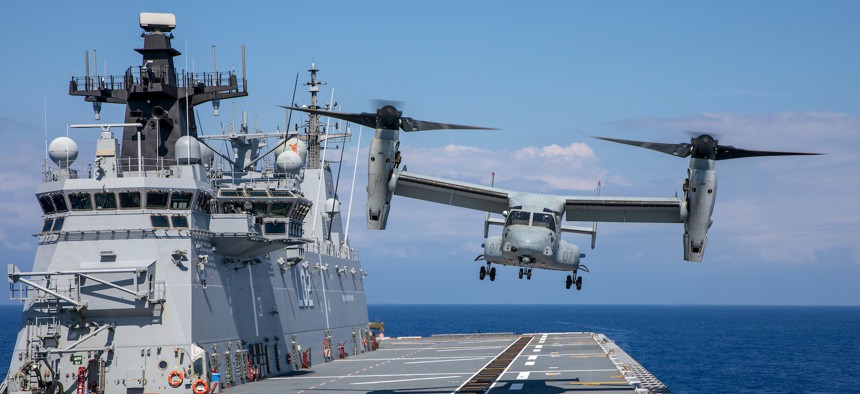
A U.S. Marine Corps MV-22B Osprey performs deck landing maneuverers aboard Royal Australian Navy landing helicopter dock HMAS Canberra (L02) during Rim of the Pacific (RIMPAC) 2022. Royal Australian Navy / Petty Officer Christopher Szumlanski
Some Ospreys on Flight Restrictions Pending Part Replacement
U.S. military limiting the lifespan of a gearbox part to address V-22 hard clutch incidents.
The Marine Corps, Navy, and Air Force will implement a time limit on a gearbox part in the V-22 Osprey as part of the military’s efforts to resolve the aircraft’s hard clutch problem.
Air Force Special Operations Command grounded their Ospreys in August because of concerns with the hard clutch, though the Marines and Navy continued flying the tiltrotor aircraft. AFSOC returned their Ospreys to the air in September. The flight hour limit comes from the V-22 Joint Program Office’s 24 initiatives to find solutions to the problem, the official said.
“This recommendation was based on a progressive increase in these hard clutch engagement events. And from that, and looking at the totality of the data, we in recent weeks have been able to determine that this time limit was an appropriate step for us to take,” the defense official said.
The recommendation does not stop flight operations; however, a “subset” of the tiltrotor aircraft with assemblies that have already exceeded the limit will be on flight restrictions until the part can be replaced, the defense official said.
The hard clutch engagement problem usually occurs just after take-off, and the Marine Corps has trained its pilots to conduct a “hover check” to look at the aircraft’s instruments before continuing the flight, a defense official told Defense One in August.
“A hard clutch engagement event occurs when the clutch, driven by the engine, releases from the rotor system and suddenly re-engages, sending an impulse through the drive train, potentially causing damage,” the defense official told reporters Saturday.
The clutch, which “enables single-engine operation of the V-22,” is inside the input quill assembly, “the part that connects the engine to the drive system,” the defense official said.
Citing “operational security concerns,” the defense official would not provide the new flight hour limit, nor the number of Ospreys affected.
Manufacturer Bell-Boeing is working on a complete redesign of the clutch, which is part of the long-term goal of finding a permanent fix for the hard clutch engagement problem, the defense official said.
Until then, mechanics will replace maxed out input quill assemblies at the squadron level. Squadrons already have the parts, equipment, and procedures necessary, the defense official said.
Once the assembly is replaced, it should work for years, a defense official said.
“Timelines to hit that threshold are based on overall flight time on the asset and will vary. This is a mid-term mitigation to reduce the likelihood of a hard clutch engagement event; we will continue to follow the data and update our mitigation efforts,” the defense official said.




